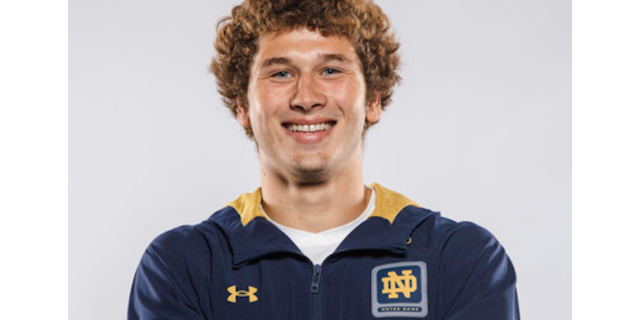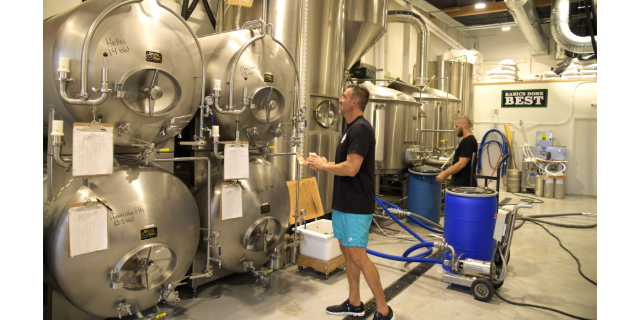EOU teaching program bridges classroom theory with hands-on teaching
Published 6:00 am Tuesday, January 30, 2024

- Eastern Oregon University student Taylor Tibbets instructs a student at La Grande Middle School. Tibbets is partnered with LMS teacher Kindi Irvin as part of the the EOU College of Education’s full-time, intensive Master of Arts in Teaching program, which blends full-time in-classroom professional experience with academic preparation.
LA GRANDE — An Eastern Oregon University program is fast-tracking potential teachers into the classroom.
Trending
The school enrolled 53 teacher candidates last July into its fast-track Master of Arts in Teaching program that will prepare them for careers as licensed elementary or secondary education teachers with master’s degrees.
Candidates fall into one of two cohort categories. The elementary cohort are students working on becoming elementary school teachers and the secondary cohort are students working on endorsement in their specialty areas like music, art, physical education, English language arts and all the sciences. The program is designed to be completed in 10 months, however there is an option to complete the program over two academic years.
“Traditionally this is a 10-month program, so we start in the summer term and through the following spring term,” EOU Graduate Programs Advisor Kristin Johnson, who assists the MAT teacher candidates in the program, said. “We also have the option to spread the program out over 2 years if the candidate has been hired by a school district to be teaching in their own classroom while they are going through the program.”
Trending
The MAT program is a popular one that has been in existence for several decades.
“I went through the program myself about 19 years ago,” Johnson said. “The program has been around before that, so it’s a long-standing program.”
The MAT program has adapted and changed responding to school districts and teacher candidates’ needs, but it is a hybrid program, which allows candidates to live and do their practicum and student teaching experiences in other parts of the state or even out of state.
At the beginning of the program, the candidates come to Eastern for one week, but the rest of the course is hybrid, including online courses through a video conferencing format.
“It is an apprentice-based model where they teach in a classroom for the entire academic year,” she said, “and they are working with a mentor teacher throughout that time while they are also completing their online courses.”
It is a rigorous schedule, Johnson said, including the classroom experience along with the MAT course studies and homework all packed into the 10-month period or extended over the 2-year program period, whichever the candidate chooses. Some of the students hold jobs teaching with restricted licenses but others are entering the program traditionally with no teaching position in place with any district.
Traditional teaching candidates
Traditional candidates are unpaid for their classroom experience because they are working alongside their mentor teacher in the same classroom. One MAT traditional secondary candidate, Garrett Beckman of Lewiston, Idaho, was placed in Imbler High School last July to focus on licensure for specific classes taught in secondary education schools.
“My content specialty is physical education and health instruction,” he said. “I worked with mentor Darci Sweet and now my mentor is Tony Haddock.”
Beckman will begin teaching his own lessons with Imbler students and Haddock will be supervising the classroom. In physical education, Beckman is teaching weightlifting, and in the health class, his curriculum includes talking about healthy relationships, nutrition, the body system, sex education, mental health and, of course, drug, alcohol and tobacco health hazards.
“My contract day begins at 7:45 a.m. and ends each day at 4 p.m.,” he said. “I’m not paid to teach except if I’m substituting for my mentor teacher because he’s absent.”
Beckman finishes his school day at Imbler, and then he goes back to one of the coach’s homes where he is living during the school year. There he has to hit the books for the evening, studying and doing his homework for the MAT program.
“You have to be a responsible person to finish this course in 10 months,” he said. “You must have good time management skills and complete your homework. You also need to be organized and be a good communicator with people in your school.”
Candidates with restricted licenses
Over 60% of the MAT students are teachers with restricted teaching licenses and are already teaching and being paid for teaching in the classroom. They have their own classrooms and are not working with a mentor teacher. Daily they do consult with another teacher who is assigned as their mentor to discuss how the day went. These student teachers earn as they learn, and the district hires them, knowing that they are working toward teacher licensure.
“There is such a teacher shortage, that the districts don’t have enough teachers applying for the positions that they have and are looking for,” Johnson said. “So, they seek others with restricted licenses to teach with the understanding that they will get their teacher’s licensure within three years.”
Adyson Shaw is teaching with a restricted license in Parma, Idaho, and she is teaching 20 fourth-grade students at Maxine Johnson Elementary School.
“My mentor is a teacher of another fourth-grade class,” Shaw said.
At the end of her school day, Shaw is coaching seventh-grade boys basketball. After that, she returns home to her husband and then starts her MAT homework for the day. It’s a rigorous schedule for an expectant mother, and it usually ends between 9:30-10 p.m.
“It’s worth all the hard work though,” she said. “The MAT administrators and professors have been amazing. I’m already seeing the professional growth in myself since I started this MAT program.”
The 2-year MAT program
Joshua Roberts, a MAT teacher candidate, is teaching on a restricted license at Riverside Junior Senior High School in Boardman. He chose the two-year MAT program because he’s a new parent, so he needed a more flexible schedule to meet all his responsibilities.
“My content specialty is U.S. History, social studies, psychology and finance,” he said. “I hope to stay working in this area after graduation because I was born and raised in Hermiston.”
Roberts’ day at school ends at 3:30 p.m. but then he returns home to do his MAT studying, grading his pupils’ work and doing his own lesson planning. Roberts said that going through the MAT program requires a good support system.
“I enjoy teaching, and I’m looking forward to graduating this spring with my teaching license and master’s degree,” he said.
A master’s degree isn’t required for teachers in Oregon or most states, however, teachers can rise on the pay scale with a master’s degree. Some find the MAT program appealing to fast track their way to a teaching license and a master’s degree.
Every year, EOU’s MAT program attracts between 50 and 75 teacher candidates.
“Currently, we have 53 students divided into two cohorts, an elementary cohort and a secondary cohort,” Johnson said. “Of those 53 students, nine are doing their MAT course work and apprenticeships in Union County, and the remaining 44 are doing their apprenticeship outside the county or even outside the state of Oregon.”
The tuition for the elementary cohort is $520.80 per credit and there are 56 credits for the elementary cohort and 45 credits for the secondary cohort.
The MAT Program Placement Coordinator assists teacher candidates in finding a district within their residential area where they can do their apprenticeship for the MAT program. The coordinator places the candidate in those schools willing to accept them.
If a university graduate is interested in acquiring their teaching licensure and master’s degree through the MAT program, they are encouraged to call EOU Graduate Programs Advisor Kristin Johnson at 541-962-3529 or email her at Kristin.johnson@eou.edu.









